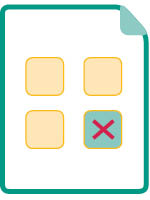
Rate this article and enter to win
Staring at a blank Word document and willing it to magically transform into a killer résumé can give anyone anxiety—no matter how much experience you do or don’t have.
“[I struggle with] making my limited experiences sound valuable (i.e., identifying my skills and presenting them in a way that exemplifies my ability to learn/be trained/do the job well).”
—Emily, fourth-year undergraduate, Portland State University, Oregon
Think of it this way: Sitting down to make or update your résumé is a chance to show off all your hard work and think really specifically about your career goals. With the right tips, building your résumé can actually be enjoyable (and, failing that, it’s at least useful).
To fix up your résumé, follow these tips and check out our sample résumé below.
 1. First, make the list
1. First, make the list
- Make a detailed list of all your professional, educational, and extracurricular experiences. This exercise will help you remember everything you have done.
- Save this list. It might be useful if you need to fill out a form for your complete work history.
- Pick out the best stuff: everything that’s relevant to your intended career.
Now you’re ready to start making this look fancy.
 2. What to spotlight
2. What to spotlight
Make this info very easy to find. This is what people who look at résumés focus on:
- Your name
- Your education, with dates
- Your current job, with dates
- Your previous jobs, with dates
 3. What to include
3. What to include
- Specific accomplishments, quantified wherever possible.
- “The résumé shouldn’t be one’s entire life story,” says Dr. Darby Scism, executive director of the career center at Indiana State University. “It’s a snapshot of your most significant work and professional experiences, accomplishments, and skill sets.”
- Remember, there are other ways (including cover letters and interviews) to present what isn’t on your résumé.
 4. What to avoid
4. What to avoid
- These are the seven most overused buzzwords, according to the career networking site LinkedIn: energetic, passionate, tenacious, value-add, expert, ninja, guru.
- Terms like “references available upon request” are implied. Delete them to save space.
- Typos. No self-respecting résumé can recover from a typo. Find a detail-oriented friend, print your résumés, and proofread them bottom to top. Then do it again with someone else.
 5. Keep it simple and easy to scan
5. Keep it simple and easy to scan
- Use bulleted lists instead of paragraph descriptions. “The résumé needs to be easy to read, with clearly marked section headings and bullet points,” says Dr. Scism.
- Use an easily readable font.
- Always send your résumé as a PDF to ensure your formatting stays pristine no matter where it’s downloaded.
- Don’t stress over the design. “A lot of students are told it’s about design and standing out, but it’s really about readability,” says Nicole Isenhour, a career consultant with Point Road Group in New York City. “Having your prospective employer be able to find everything they need to within 30 seconds is a little more important than making it pretty.”
- Avoid shading. “It can come out as too saturated and illegible on some printers,” Isenhour explains.
- Don’t include a photo, your date of birth, or your race—it’s illegal for an employer to make hiring decisions based on age or race.
Here’s a sample résumé that gets it right
Include a summary

When an employer reviews your résumé, within the first few seconds they should have a clear understanding of the type of position you are targeting. The best and most modern way to accomplish this is by writing a summary section. This is sometimes called a career objective statement.
The summary section should include:
- The type of work you’re seeking
- The specific job or field
- The skills you’re contributing
- The value of those skills to the company
“This section can take up a lot of space and is often poorly written. Many of these details are included in a cover letter and can be removed from the résumé. However, if there is no cover letter, a Career Objective statement is necessary.”
—Kara Renaud, career services resource coordinator at Brock University, St. Catharines, Ontario
“Availability is often the most important thing for retail or food service jobs. Consider adding an availability chart at the bottom of the page.”
—Paul Goodrick, career advisor at Ryerson University, Toronto, Ontario
A résumé is a marketing document. If a piece of data you’re including is not relevant to the type of work you’re seeking, there’s no harm in leaving it off.
This is especially true of volunteer work, training you have completed, or other activities. If you keep it in, find a way that does not dilute the focus of your résumé.
…But not too selective
Don’t leave out relevant experience, accomplishments, and credentials just to make your résumé shorter.
But do keep it to one page—two if you feel you absolutely need it. Ideally, one page is all it should take to communicate to an employer that you know what skills they’re looking for and can bring them to the position.
Demonstrate your commitment to your career goals
Include on your résumé:
- Courses that are relevant to the work you are targeting
- Relevant projects and extracurricular activities
- Memberships of relevant professional organizations (to enhance your credibility)
Pay attention to dates. If you are still working on your degree, say: “Graduation anticipated 2020” (or whatever year).
Layout essentials
- Add space between sections
- Use bullet points
- Use different size fonts:
- 14–16pt for headings
- 12pt for primary text
- 10–11pt for bullet points
- Consider elements like horizontal lines, columns, or other design elements. But make sure it looks professional, not cluttered. Before you send it anywhere, print a black-and-white copy to make sure everything is legible.
Demonstrate your positive traits in action
Use examples from your work history or your education.
For example: “Reorganized the office at Leaps & Bounds Rabbit Rescue, creating a filing system that saved two hours daily.”
Focus on your accomplishments
Show how your employer benefited from your work. For some positions, this can be challenging, but you should still make an effort. On what factors was your performance assessed? How did you know you were doing a good job? What did you improve?
For example, don’t just write, “Helped with clerical tasks.” Instead: “Assisted with clerical tasks, saving teachers four hours daily and enabling them to spend more time with students.”
Bulleted accomplishment statements are more user-friendly than paragraphs.
Sample résumés for students: Adventures in Education
College résumé sample: Monster.com
Article sources
Michelle Dumas, founder, Distinctive Career Services, Boston, Massachusetts.
Paul Goodrick, career advisor, The G. Raymond Chang School of Continuing Education, Ryerson University, Toronto, Ontario.
Nicole Isenhour, executive career consultant, Point Road Group, New York City.
Kara Renaud, resource coordinator and faculty liaison, career services, Brock University, St. Catharines, Ontario.
Darby Scism, PhD, executive director, career center, Indiana State University, Terra Haute.
Black, J. (2018, February 20). Most overused buzzwords 2018. LinkedIn. Retrieved from https://www.linkedin.com/pulse/most-overused-buzzwords-2018-jennifer-black-/
Fisher, A. (2011, June 3). Top 5 mistakes on executive resumes. Fortune. Retrieved from http://fortune.com/2011/06/03/top-5-mistakes-on-executive-resumes/?section=money_topstories
Gordon, W. (2011, March 5). Top 10 ways to rock your resume. Lifehacker. Retrieved from http://lifehacker.com/5777317/top-10-ways-to-rock-your-resume
Keeping an eye on recruiter behavior. (2012). The Ladders. Retrieved from http://cdn.theladders.net/static/images/basicSite/pdfs/TheLadders-EyeTracking-StudyC2.pdf
Sharma, M. (2010, December 14). Top 10 profile buzzwords. LinkedIn. Retrieved from http://blog.linkedin.com/2010/12/14/2010-top10-profile-buzzwords/


























